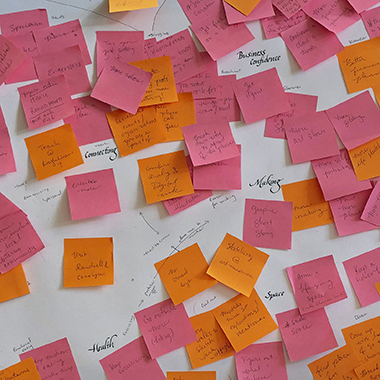Setting Purposeful Goals
an introspection fest to objectives and key results
During my holiday break, I realized I needed to step-up and make some changes on how I was running my business. Aimless and taking it only one problem at a time, wasn’t getting me where I wanted to be. I had lost sight of where that even was and what I wanted to be working towards. It was time to take a step back and do some serious goal setting. These needed to be “sky’s the limit” goals with the purpose of focusing myself daily on who I am and why I’m showing up. I tend to be practical—to a fault. So I needed to find a way to break myself out of my that-is-totally-doable bubble and actually brainstorm the future.
After loads of internet research, reaching out to my community, and chatting it over with my super supportive partner, I decided I would treat this like a project for a client. This included taking the time that was necessary to brainstorm not just goals, but goals that were not immediately obvious. To do this, I used a combination of the brainstorming skills I learned in design school, and the K-J method. Then planned to implement them as Objectives & Key Results (OKRs).
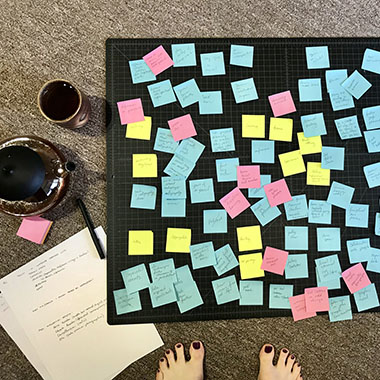
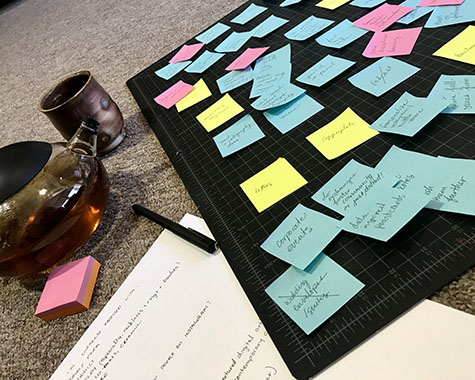

It was time for an Introspection Fest (dubbed by Grace D. Chin). Needing to disconnect myself from my usual routine, I made a pot of tea, put on some upbeat music, and took a seat on the floor. My first step was to write down every goal related thought I had. Each thought got a post-it and got stuck to my giant cutting mat. This was not a time for judgements. I needed to write the ideas down so I could move on and have new ones. The idea here was to exhaust all ideas, whether good or bad. The flow of writing ideas eventually ebbed. At this point, I changed the music, did some dishes. Then sat down again to write more ideas.
Once I thought I had come up with everything, I went online and watched some TED Talk videos about goal setting. I searched for prompt questions that would get my juices flowing. I asked myself, why I was afraid of goal setting—why I was afraid of dreaming bigger. Acknowledging these fears unlocked more ideas.
I made a list of everything that makes me happy. I made a list of everything I did last year. Then evaluated how that affected the rest of the year (good and bad), what I learned, and if it was worth doing again or valuable enough to continue. I asked what kind of projects I wanted to work on in the future. What do I want my artwork to look like? I listed artists that inspired me and why. I asked what I wanted to learn and what I wanted to share. I researched what others like me were doing on social media, and analyzed if that was something I wanted to do, something I should do, or something that didn’t fit with my vision.
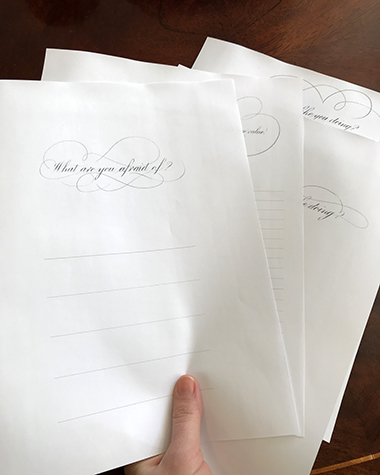
Click on the image to download free hand-lettered goal prompt worksheets.
After everything was listed. And all ideas were put on post-it notes and stuck to my cutting mat (a wall is probably a better idea). I went to bed. They were written down, they didn’t have to be a burden anymore.
The next afternoon, after some mental distance, I started to sort through the notes. Categorizing them to form a larger picture. I had a personal, business, learning, art, and misc goal categories. Each category was then piled by hierarchy—with dominant goals and subgoals piled beneath them. At this point, the post-its had lost all sticking power, so it was time to digitize them. I chose to use Asana’s board feature (but Trello or a mind-mapping tool would also work well). Each category was a column, each dominate goal—a task, and each subgoal—a subtask. As I organized these goals, a common theme became clear through all of them. A word I could turn into my mantra for the year. Something that could keep me pushing forward. A word I could remember even when not currently thinking about my goals.
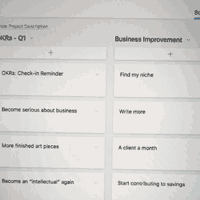

Further.
I know what my goals are now. I just need to implement them into my life. My partner has taught me the importance of breaking large goals into measurable pieces. Coming from the start-up industry, he shared his knowledge of OKRs. The basic idea is to choose a few objectives to focus on at a time. For me, these were the dominant goals that I had listed as main tasks. These don’t need to be measurable in themselves because your key results (the subtasks) should be. Each objective will get a few key results. These key results are the actionable items that will help you reach your larger objectives. Once you’ve written your plan, you can revisit them at least quarterly to measure your progress by percentage. The general rule of thumb here is to aim for 70%. Much higher and your key results are too simple and should be readjusted.
The perfectionist in me is very intimidated by this new system. However, it's been a few weeks since I did my initial Introspection Fest and the ideas I came up with still invigorate me. Working on your own can make focusing a challenge, but so far having my goals written out has helped drive me forward daily.
Before this process, I was afraid of setting goals I couldn’t meet or that I would lose interest in. But through this process, I've learned that it’s okay to change your mind. Your life isn’t stagnant and your goals shouldn’t be either. They are there to help give your life direction.
Some great resources I used while setting my goals:
-
Lara Casey Blog note: her Powersheet Goal Planner looks awesome, and I might use that next time.
 Katie Leavens
Katie Leavens
